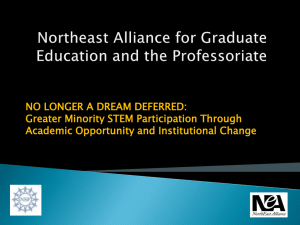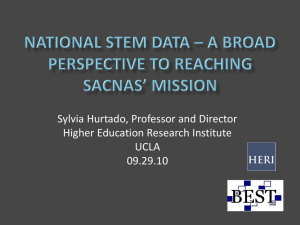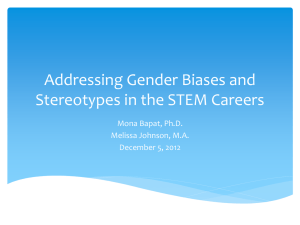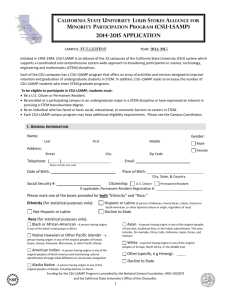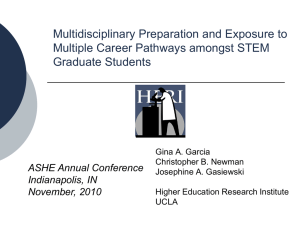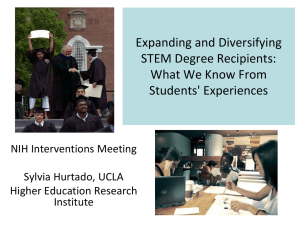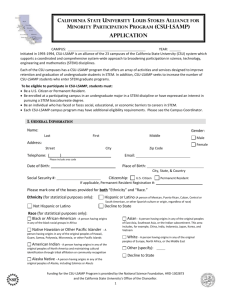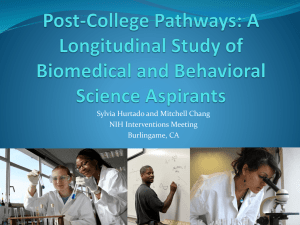The Impact of Undergraduate Research Programs on Enrollment in
advertisement
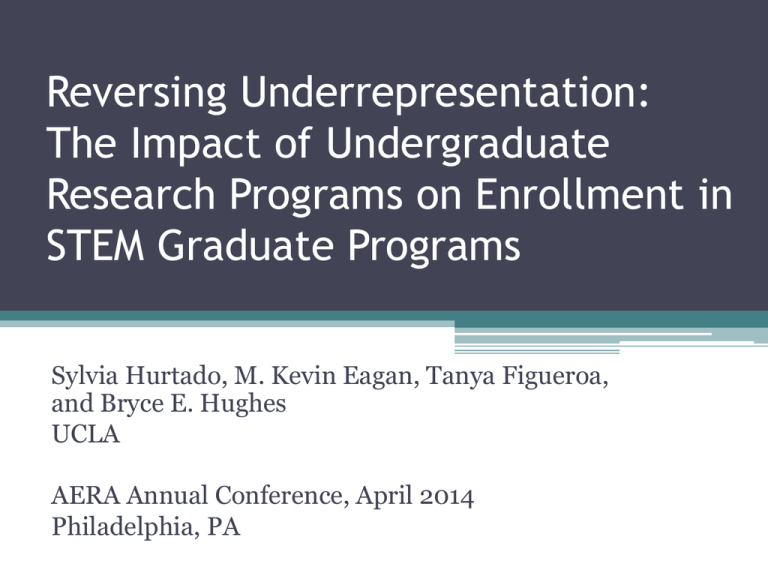
Reversing Underrepresentation: The Impact of Undergraduate Research Programs on Enrollment in STEM Graduate Programs Sylvia Hurtado, M. Kevin Eagan, Tanya Figueroa, and Bryce E. Hughes UCLA AERA Annual Conference, April 2014 Philadelphia, PA Introduction • American Indian (0.4%), Black (3.8%), and Latina/o (4.1%) students remain terribly underrepresented in STEM graduate programs • Federal and private agencies have invested heavily in undergraduate research programs to increase their participation in graduate school • However, very few studies have been able to test the effect of undergraduate research participation on graduate school enrollment using experimental or quasi-experimental techniques Purpose • To examine the effect of participation in undergraduate research on enrollment in STEM graduate programs. ▫ Specifically, this study tests this effect for college students in general as well as URM students in particular. Literature Review • Undergraduate research experiences (URE) can help URM students overcome many of the unique racial barriers they face in STEM • UREs also promote skill development and the enhancement of science identity requisite for success in STEM • Many studies have identified UREs as a significant factor in the decision to enroll in a STEM graduate program, but a causal relationship has yet to be established Conceptual Framework • Undergraduate research experiences as communities of practice (Lave & Wenger, 1993) ▫ Mutual engagement around a common enterprise ▫ More than “learning by doing”: Authentic participation leads to development of a shared identity ▫ Outcomes: Increased sense of belonging and desire to move from peripheral to full participation Data Source and Sample • Longitudinal dataset: ▫ 2004 CIRP Freshman Survey ▫ 2011 Post-Baccalaureate Survey ▫ Integrated Postsecondary Educational Data System • 7331 students across 471 institutions Variables and Measures • Dependent Variable ▫ Whether student enrolled in STEM graduate program within 7 years of college entry, dichotomous • Independent Variables ▫ ▫ ▫ ▫ Participation in undergraduate research Demographic and pre-college experiences Aspirations and dispositions Institutional characteristics Predicting Research Participation Structured Program Latino (vs. White) ++ Black (vs. White) +++ Research with Faculty Research with Faculty or through Program Native American (vs. White) + Pre-College research experience +++ +++ +++ Degree aspiration: Ph.D. +++ +++ +++ Career Aspiration: Research Scientist ++ +++ +++ ++ + HS GPA Effect of Research Participation on STEM Graduate/Professional School Enrollment Delta-P All students: Structured program 0.09 All students: Research with faculty 0.14 All students: Any research 0.14 URM students: Structured program 0.15 URM students: Research with faculty 0.14 URM students: Any research 0.17 Discussion • Research participation significantly improves STEM bachelor’s degree recipients’ probability of enrolling in STEM graduate and professional programs • Mode of research engagement may not matter as much as engagement in and of itself • Incentivizing faculty to include undergraduates in their research Future Research • Identify the specific components of research experiences that correlate with increased rates of STEM graduate/professional school enrollment • Examine the ideal timing of UREs Contact Us! Faculty/Co-PIs: Sylvia Hurtado Kevin Eagan Graduate Research Assistants: Tanya Figueroa Bryce Hughes Administrative Staff: Dominique Harrison Papers and reports are available for download from project website: http://heri.ucla.edu/nih Project e-mail: herinih@ucla.edu This study was made possible by the support of the National Institute of General Medical Sciences, NIH Grant Numbers 1 R01 GMO71968-01 and R01 GMO71968-05, the National Science Foundation, NSF Grant Number 0757076, and the American Recovery and Reinvestment Act of 2009 through the National Institute of General Medical Sciences, NIH Grant 1RC1GM090776-01. This independent research and the views expressed here do not indicate endorsement by the sponsors.
